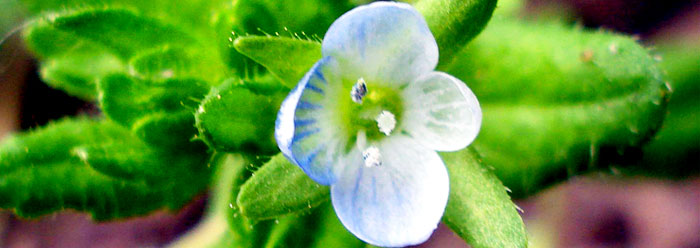Just one genus of flowering plant, Veronica, includes over 450 different species. They share similarities with other flower genera, some of which have radially symmetrical flowers and others with bilaterally symmetrical flower petal arrangements. Could varieties that look so different have descended from the same flower stock?
To investigate this question, researchers from the University of Kansas recently compared the flowers' gene sequences. More specifically, they compared genes of a bilaterally symmetrical flower…a structure they believe evolved to aid bee pollination…with those of a Plantago and an Aragoa species, which are radially symmetrical and are pollinated by wind. The scientists wondered how these related plants could have developed such radically different appearances and pollination strategies.
Their results were published in the Proceedings of the National Academy of Sciences. They wrote, "Our findings support the hypothesis that radially symmetrical flowers in the Aragoa/Plantago lineage evolved gradually through gene duplication, expression diversification, and degeneration in the symmetry developmental genetic pathway."1 In other words, certain flowers developed a radially symmetrical structure because they lost the genetic ability to produce bilaterally symmetrical flowers.
A closer look at each of these three real processes will reveal a gaping hole in the evolutionary mindset that served as the overarching backdrop for this research project.
First, "gene duplication" refers to already existing genes that are duplicated or copied, then spliced back into the genome. This is common in plants, but it does not involve the introduction of any new genes. Thus, it is powerless to explain how nature could have developed a gene from scratch. And nature must have made millions of genes, if big-picture evolution is accurate.
Second, "expression diversification" refers to variations in how often and when a gene is accessed and used by a cell, and in this context refers to flower embryo cells undergoing division during the plant's development. That the flower was programmed with this ability from the beginning is a reasonable conclusion, given the high degree of specificity involved in altering gene expression, which could be a fatal activity if not precisely monitored. If so, then these subtle variations add no fundamentally new genes or information. Rather, the variations are a product of pre-existing plant programming. This kind of intentional programming was not ruled out by the results of this investigation.
Last, "degeneration" refers to the breakdown of previously functional genetic information. Some of the plants the scientists investigated had lost some of the genes required to develop bilaterally symmetrical flowers. But how does losing genetic information help big-picture evolution build any of the new information that life forms would need to evolve into completely different forms?
In a University of Kansas press release, the study's senior author, Lena Hileman, said:
Organisms adapt to their local environments and what resources they have available to them. If a lineage of plants finds itself in an environment where bee pollinators or any type of biotic pollinators are limited, then an alternative strategy, and under those conditions a better strategy, might be wind pollination.2
Apparently, the plants lost genes as part of a survival strategy that enabled them to adapt to, and fill, various environments. But none of the tactics used to fulfill this strategy―gene duplication, expression variation, or degeneration―serve big-picture evolution in any way. Certainly, flowers can change to fit new environmental niches. But the processes they use to do so offer no evolutionary answers to the question of where the flowering plants came from in the first place.
However, a clear answer is given in Genesis 1, which indicates that God created land animals to be fruitful and fill the earth. To provide for these animals, He gave every green plant for food.3 So, it stands to reason that He would have intended plants to produce varieties that would fill "their local environments," and that He would have given them the genetic and cellular equipment to do so.
References
- Preston, J. C, C. C. Martinez and L. C. Hileman. 2011. Gradual disintegration of the floral symmetry gene network is implicated in the evolution of a wind-pollination syndrome. Proceedings of the National Academy of Sciences. 108 (6): 2343-2348.
- Research shows entire group of genes vanishing in the evolution of flowers. University of Kansas press release, February 16, 2011.
- Genesis 1:30.
* Mr. Thomas is Science Writer at the Institute for Creation Research.
Article posted on February 28, 2011.





















